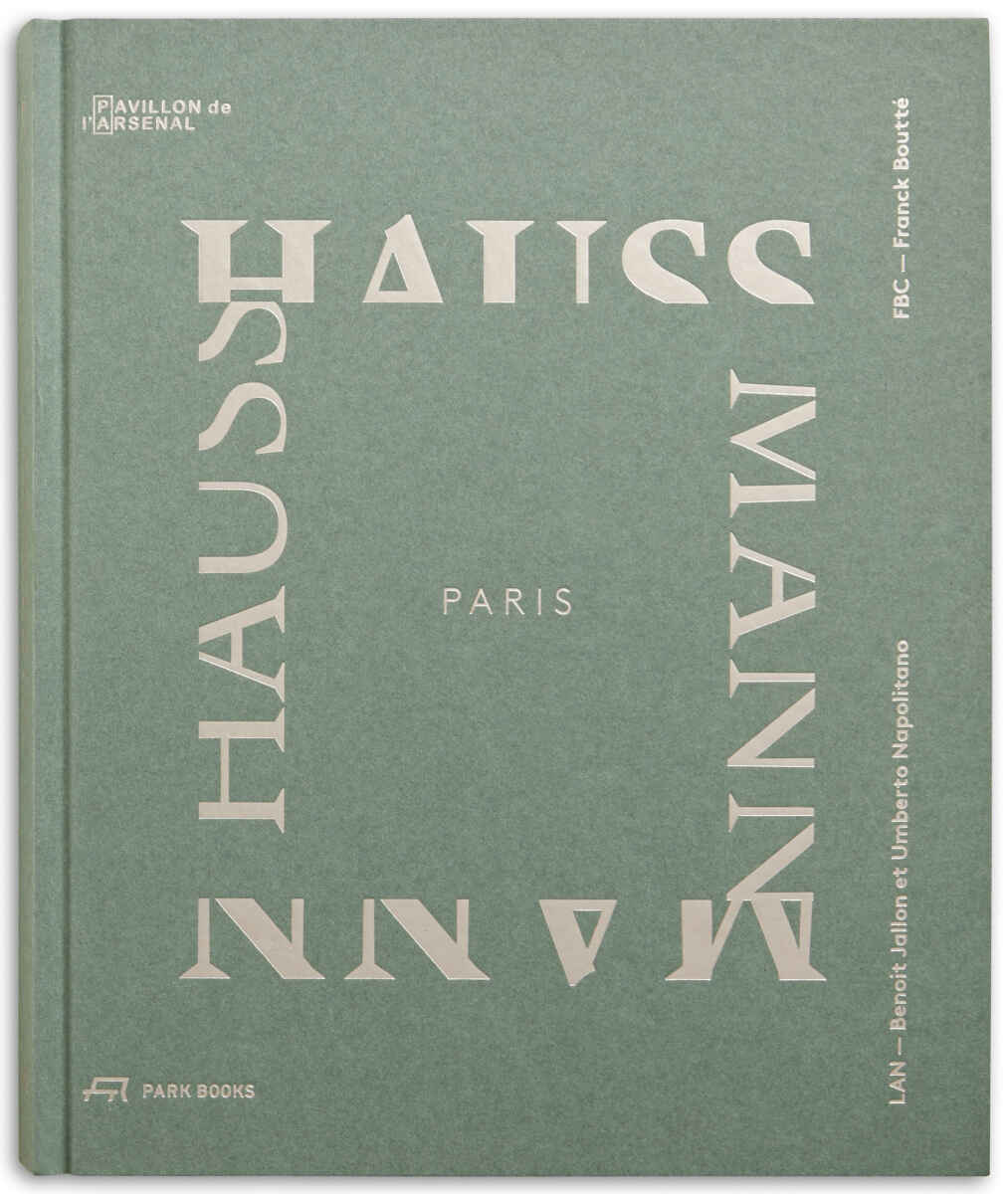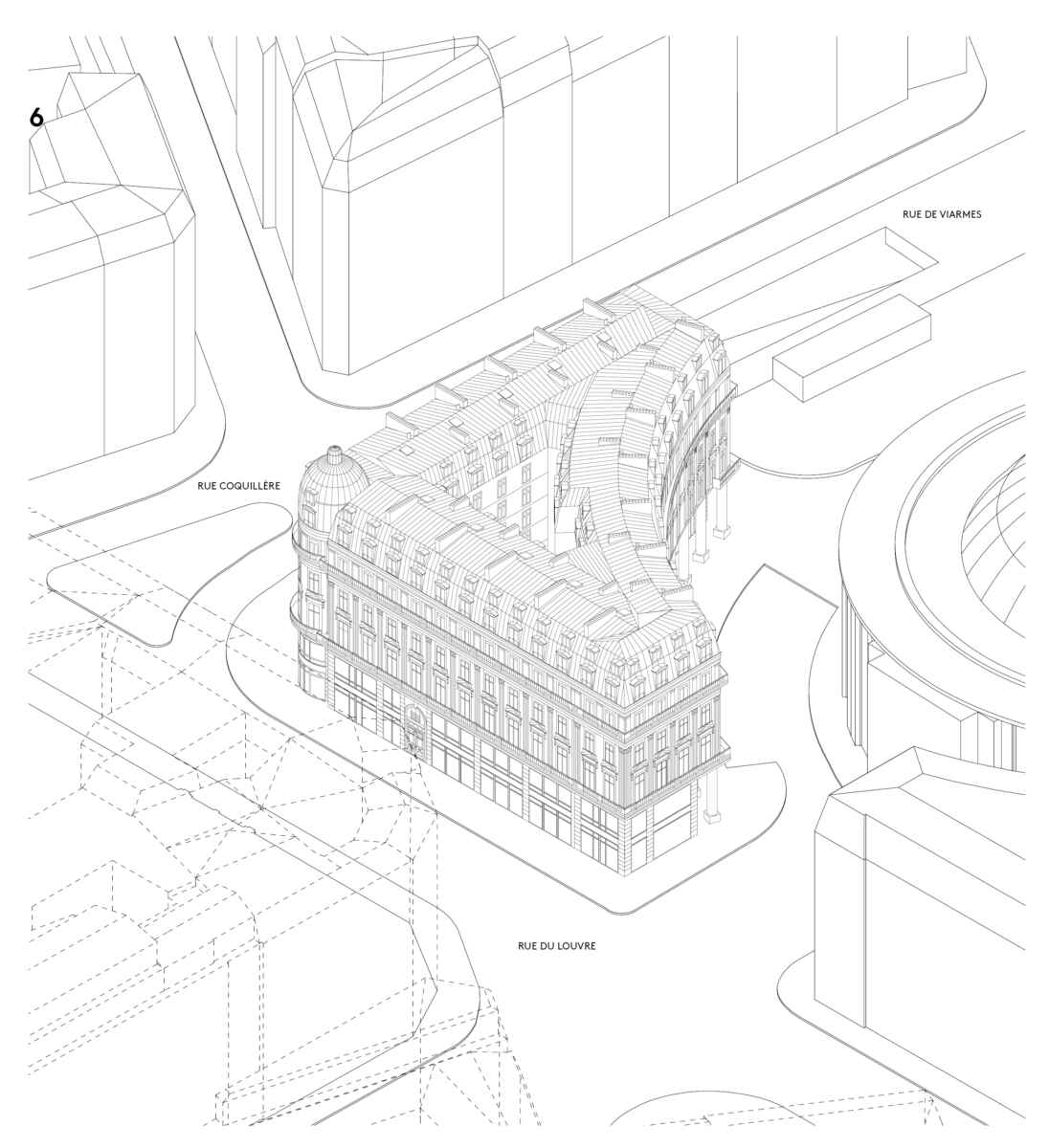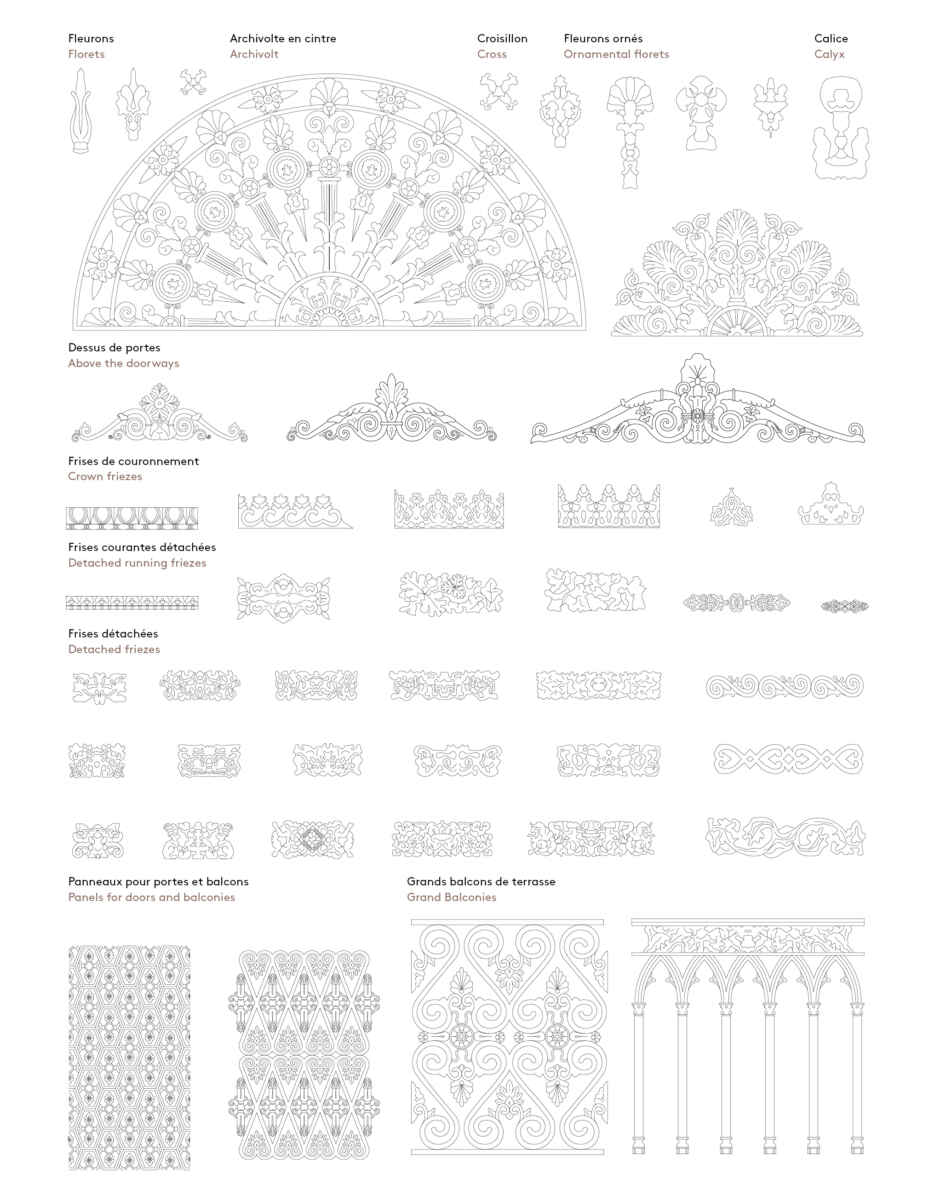
The famous Baron Haussmann, born Georges Eugène Haussmann (1809-1891), was largely responsible for the major public works (les Grands Travaux) of the Second Empire, which shaped modern Paris.
The catalogue for the 2017 exhibition Paris Haussmann: A Model’s Relevance at the Arsenal de l’Arsenal in Paris has been republished in 2023 by Park Books: 263 pages; bilingual: English and French; ISBN 978-3-03860-219-4; accept all cookies to go directly to the catalogue’s Amazon page (we earn a commission): Amazon.com, Amazon.co.uk, Amazon.de, Amazon.fr).
Alexandre Labasse, Directeur général du Pavillon de l’Arsenal, writes in his introduction to this valuable publication that Haussmann’s myth grew during his mandate, thanks to Jules Ferry’s pen and caricatures in the satirical journal Paris Comique. It comprises a time and space far greater than that of the works he oversaw. His plans were based on previous studies and works. They form a palimpsest of the studies and plans made by his contemporaries, such as the first Plan d’Ensemble for the breachings that Jacques Séraphin Lanquetin, President of the Municipal Commission, developed in 1839, or the works credited to his predecessors at the Seine prefecture, especially those carried out by Claude-Philibert Barthelot, comte de Rambuteau, between 1833 and 1848, and Jean-Jacques Berger between 1848 and 1853.
The Haussmann myth was reinforced by the Baron’s selective Mémoires, in which he describes the architect Eugène Deschamps, author of the Plan de Paris (1852-1853) as a simple “draughtsman”, and in which Haussmann downgrades Napoléon III to the “program’s inspiration”. Alexandre Labasse underlines that, inspired by his time in London from 1846 to 1848, the Emperor announced in his “Embellishment Project” in August 1853 for instance that “the height of houses shall always be equal to, and never greater than, the width of the streets”, “a map describing all the improvement projects shall be printed and made public”, and “the plan shall extend all the way to the fortifications”
Alexandre Labasse mentions that the current perception of Haussmann’s Paris not only attributes actions and commitments concomitant with or prior to his Parisian mandate; it also assigns to him a number of projects and developments after his dismissal on January 5, 1870.
Alexandre Labasse mentions for instance that the buildings constructed under the successive edicts of 1882, 1884 and 1902, which were supposed to break with the austerity of their predecessors, preserved the principle of shared walls and the continuity of the buildings’ alignment along the edge of the street. In addition, building permits, issued under the authority of the corps of architectes voyers, the builders of streets, railways and waterways – who had often been recruited by Haussmann –, enacted both the prefect’s strategy and his system.
Alexandre Labasse concludes that, by the beginning of the First World War, the city appeared fully Haussmann-ized. Baron Haussmann’s influence exceeds that of his century, and merges with the very notion of Paris. In other words, Haussmann’s Paris is an urban cityshape not developed by just one man, but that one man had a great influence beyond his time of retirement.
Alexandre Labasse states that the exhibition catalogue Paris Haussmann (Amazon.com, Amazon.co.uk, Amazon.de, Amazon.fr) explore this homogenous, polymorphous cityscape created as a derivation or transformation of a previous form that became part of a longer process, one that proved itself capable of changing and evolving. The study uses the form to transcend history. It accounts more than it recounts. Removed from a chronology of official documents or the responsibility for facts and events, it keeps its distance from manuscripts, memoirs, chronologies, archives, engravings, paintings and the first photographs made from glass-plate negatives. According to Alexandre Labasse, this book instead seeks to map, measure and quantify our own urban-ness. It sketches out the full spaces and assesses the empty ones. It thus frees the architecture of its content and initial function, as it itself has often done over time. Devoid of its function and varying in its uses, each architecture reveals its true nature and, paradoxically, its identity. Paris Haussmann visually categorizes and compares the main axes, identifies the public spaces, organizes the blocks and buildings in function of their current geometries. It looks at form as a way of understanding meaning. Or, as ironically Victor Hugo, one of the Haussmann system’s most prominent detractors, wrote in Les Contemplations [1830-1855; Paris, M. Lévy, 1856]: “form is the substance that rises to the surface”.
Alexandre Labasse underlines that the exhibition and the catalogue Paris Haussmann provide a reinterpretation of the city of Paris, both in terms of its volume and its histories and usages. The architects Umberto Napolitano and Benoit Jallon and the architect and engineer Franck Boutté offer a new Haussmann tree diagram according to contemporary criteria of mobility, practices and consumption. How “walkable” is the Haussmann urban fabric compared to other metropolitan networks? What is the density of the Parisian model compared to international standards? What is the efficiency of the built footprint at the block level in relation to contemporary typologies? Through the visualization and the development of technologies and calculations, Umberto Napolitano, Benoit Jallon and Franck Boutté provide a fresh, rejuvenated description of the Haussmann form that considers the challenges faced by today’s cities, which strive to be sensible, environmentally sustainable, dense, intense, agile and to create new paradigms that define an urban and architectural model whose primary quality is that it is already proven and admired.
Alexandre Labasse stresses that Georges Eugène Haussmann aimed to transform Paris into an exemplary industrial society. He intended to fulfill at once social aspirations, human needs and technological evolutions. This plan was supported by a century of experimentation. The exhibition and catalogue seek to qualify, quantify and calibrate the criteria of the somehow still largely unknown Haussmann model.
The first part of the exhibition catalogue is dedicated to the relevance of Haussmann’s model. According to the authors, the problem with new constructions around Europe lies not with the quality of each individual architecture, rather in the lack of a vision of the whole. They haven’t succeeded in forging a new sense of identity or in contributing to the existing identity of the places that host them. The authors claim that they have deciphered the properties of Haussmann’s urban fabric through a process of dissection, classification and comparative analysis.
The first part offers chapters regarding the typology of the urban fabric, a typology of the public space, information about the efficiency of the urban networks, urban usages and practices, a methodology and classification, a chapter about the block as an instrumentof density, about the persistence of Haussmann’s model, about the vocabulary of diversity and much more.
Regarding the vocabulary of diverstiy, the authors underline that Paris is today one of the few cities in the world where each fragment describes the whole. Like a strand of DNA, which manufactures an infinite diversity out of its four basic elements, the roofs, railings, doorways, chimneys, shutters, and all the constituent elements of the façades each express the same “idea of the city.”
The second part of the catalogue offers a typological and morphological analysis. It includes a classification of the urban networks, a classification of public spaces, a classification of the blocks (which are analyzed by dividing Paris into an orthogonal grid and by crosschecking the blocks against their built footprint), building histories, ornament catalogues and more.
The third part of the catalogue contains an efficiency analysis, including a comparative analysis of the efficiency of grids, a comparison of urban fabrics, of the morphological qualities of the block, a comparison of urban forms, information about annual direct solar exposure, about the intrinsic qualities of the building, about durability, resilience and more. For instance, to highlight the connectivity of the Haussmann road networks, the comparative analysis of fifteen cities around the world evaluates the characteristics of their grid in terms of footprint, diversification, complexity, walkability, and access to services.
These are just a few elements from a book dedicated to specialists. This is an analysis with illustrations for architects, urban planners, all kind of people who want to understand today’s relevance of Haussmann’s model. Don’t expect many photographs of present-day Paris buildings. Below you can find three “typical” illustrations from the exhibition catalogue.
Edited by Benoît Jallon, Umberto Napolitano, and Franck Boutté. Photographs by Cyrille Weiner: Paris Haussmann: A Model’s Relevance. Park Books, 2023 (first published in 2017 in context with the homonymous 2017 exhibition at the Pavillon de l’Arsenal, Paris), 264 pages, 143 color and 345 b/w illustrations, 25 x 30 cm. Bilingual: English and French. ISBN 978-3-03860-219-4. Accept all cookies to go directly to the Amazon page of the book (we earn a commission): Amazon.com, Amazon.co.uk, Amazon.de, Amazon.fr.

Page 136 Typological and morphological analysis, Block Histories. 42, Rue du Louvre © LAN. Edited by Benoît Jallon, Umberto Napolitano, and Franck Boutté. Photographs by Cyrille Weiner: Paris Haussmann: A Model’s Relevance. Park Books, 2023 (first edition 2017), 263 pages. Bilingual: English and French. ISBN 978-3-03860-219-4. Accept all cookies to go directly to the Amazon page of the book (we earn a commission): Amazon.com, Amazon.co.uk, Amazon.de, Amazon.fr.

Page 154 Typological and morphological analysis, The investment property. 3, Rue de la Paix © LAN. Edited by Benoît Jallon, Umberto Napolitano, and Franck Boutté. Photographs by Cyrille Weiner: Paris Haussmann: A Model’s Relevance. Park Books, 2023 (first edition 2017), 263 pages. Bilingual: English and French. ISBN 978-3-03860-219-4. Accept all cookies to go directly to the Amazon page of the book (we earn a commission): Amazon.com, Amazon.co.uk, Amazon.de, Amazon.fr.

Page 168 Typological and morphological analysis, The ornament catalog. Railing, door, frieze, and balcony ornaments © LAN. Edited by Benoît Jallon, Umberto Napolitano, and Franck Boutté. Photographs by Cyrille Weiner: Paris Haussmann: A Model’s Relevance. Park Books, 2023 (first edition 2017), 263 pages. Bilingual: English and French. ISBN 978-3-03860-219-4. Accept all cookies to go directly to the Amazon page of the book (we earn a commission): Amazon.com, Amazon.co.uk, Amazon.de, Amazon.fr.

For a better reading, quotations and partial quotations in this book review of Paris Haussmann: A Model’s Relevance have not been put between quotation marks.
Book review of Paris Haussmann: A Model’s Relevance added on December 13, 2023 at 22:43 Paris time.